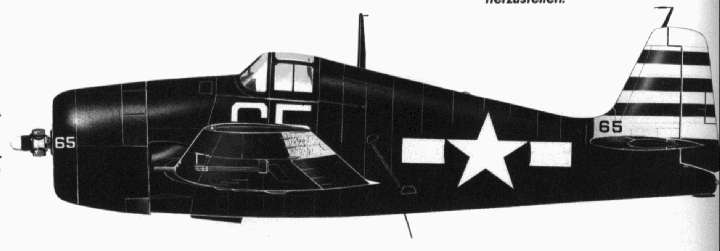

Grumman's
F6F Hellcat was devised by the firm's engineers when the flaws of
the F4F became apparent. Their task, as specified in the design notes,
as to build a better F4F. Ever since
the first ideas for the F6F where pondered, it was clear that no other
engine but either the Wright Cyclone 14, or the R-2600 of the same company
would be put into the airframe.
There would not be much
redesign as far as Grumman was concerned, for the general characteristics
of the F4F where good. However, British and US naval commanders demanded
more power, and soon, the R-2800 was chosen - the same motor that was being
used on the Corsair.
With this decision, however, the whole of Grumman's plans went into the trash - the new F6F would be a completely different plane from the F4F. Comparing the new F6F with the P-47 is not too far off the point. The plane was extraordinarily heavy, when compared to the F4F (and most contemporary fighters, including the Zero), had huge wings, and looked like a pear from the front. The engine was pointed downwards by three degrees, as where the wings to guarantee an optimal flow.
The Hellcat, as the new fighter was known, carried six 50.-caliber machine-guns in the wings and was fitted with folding wings and self-sealing fuel tanks when it was first flown in it's F6F-3 variant in October 1942. In January 1943, the first Hellcat was delivered to the Navy and the formation of Fighting Nine for the carrier Essex was begun. In it's F6F-3 variant, the fighter was just that: a fighter destined for air-to-air work. On 31 August 1943, Hellcats opened the Central Pacific offensive with an attack from carrier Essex, Yorktown, and Independence. Later that year, Hellcats contested the Japanese air supremacy over their base at Rabaul, permitting the deadly attack by Admiral Ted Sherman.
In late December, the first air battle with Hellcats led to the destruction of 28 out of fifty Zeros at a loss of only Hellcats, of ninety participating. The campaign in the Central Pacific made clear that night fighters would be needed if the security of the fleet was not to be compromised. Accordingly, as no better alternative was available, the Navy decided to put radar on the F6F, making the F6F-3N/-5N. This version of the Hellcat carried a radar on the right wing, reducing the topspeed by some 32 km/h, but giving the US pilots a valuable aid.
In 1944,
the improved F6F-5 was coming to the fleet, able to lug bombs and rockets
into battle. Now, with up to two 454kg bombs and six rockets, the F6F could
also act as a bomber. The Hellcat
secured the American air supremacy over all major areas in the Pacific,
except the Solomons where Marine Corsairs and Army Lightnings played the
prominent parts. The Royal Navy also
used the plane, flying some 1300 planes over Burma, Malaya, Japan, and
interestingly over the Ardennes as well.
|
|
Length: 10.23 meters
/33.56 ft.
Wingspan: 13.08 meters / 42.74ft. Crew: 1 Weight Empty: 4152 kilograms / 9153 lbs. Weight Loaded: 5670 kilograms / 12500 lbs. Weight Maximum: 6991 kilograms / 15412 lbs. Armament:(*) 6 x 12.7mm /50.-caliber machine-guns, three in each wing, Up to 907 kilograms / 2000 lbs. bombs and six 127mm rockets. Top Speed: 621 km/h / 386 mph Range: 1674 km / 1040 miles Ceiling: 11369 meters / 37300 feet Climb Rate: 1040 meters per minute / 3412 feet per minute |